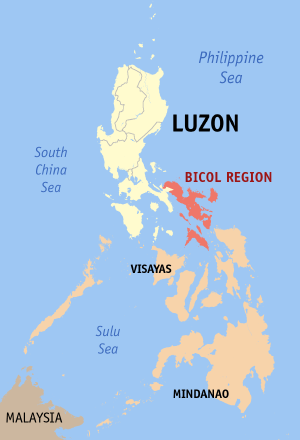The
Bicol Region (
Filipino:
Kabikulan;
Spanish:
Bicolandia) is one of the 17
Regions of the
Philippines, designated as
Region V. Bicol (also spelled
Bikol) is composed of four
provinces in the
Bicol Peninsula, the southeastern end of
Luzon island, and two island-provinces adjacent to the peninsula.
[2] The regional centre is considered to be in
Legazpi City,
Albay.
Geography
The Bicol Region is located in the southernmost tip of
Luzon Island, the largest island in the Philippine archipelago. The total land area of the region is 18,054.3 km
2 (6,970.8 sq mi),
[5] which or 5.9% of the total land area of the country. Around 69.3% of the total land area is alienable and disposable while the remaining 30.7% is public forest areas.
[2]
The region is bounded by
Lamon Bay to the north,
Pacific Ocean to the east, and
Sibuyan Sea and
Ragay Gulf to the west. The northernmost province,
Camarines Norte, is bordered to the north by the province of
Quezon, thereby connecting the region to the rest of Luzon.
History
Albay's archaeology shows concrete evidence of trade with
China,
Malaya and
Indonesia going back two thousand years. The first
Spanish contact was in 1565, when a treasure-galleon returning to
Cebu from Acapulco, Mexico, was swept off course and the captain recorded his awe at the sight of Mt.
Mayon erupting.

No comments:
Post a Comment